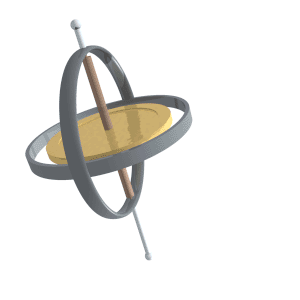
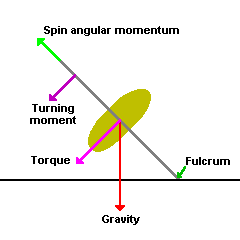
Currently, the mean angle at which the Earth's spin axis sits with respect to the plane of its orbit is 23 degrees 26 minutes and 20.4 seconds, or 23.439 degrees. This tilt, or obliquity to give it its formal name, is the reason we have seasons. When the northern hemisphere is tilted towards the Sun it is summer there (and winter in the south): when it is tilted away the situation is reversed. The programme took as its premise the theory that, without the Moon, the obliquity could vary in a chaotic way over a very large range. This would clearly be highly detrimental to life, as the seasonal variation would be greatly exaggerated. There is, in fact, some theoretical basis to this idea but the explanation of the way the Moon probably stabilises the obliquity was wrong in all respects!
The programme claimed that the stability of the Earth's axis was due to its spin speed. This was illustrated by a rapidly-spinning basketball, which was shown balancing on the presenter's finger. Unfortunately, there are many holes in this argument. Firstly, if spin speed is the determinant why is Mars thought to be considerably less stable than the Earth despite spinning with almost exactly the same period (24.62hrs) and why is Venus not dramatically unstable as it takes all of 243days to turn on its axis? Also, given that the influence of the Moon is decreasing the spin rate of the Earth how can it be said to be assisting its stability? In which regard, at no time was it ever stated how the Moon is achieving the stabilisation - a bit of an over-sight!
In fact, the basketball example was [almost] completely irrelevant. The ability to balance the ball upright has almost nothing to do with the stability of its obliquity (which is, by definition, zero when it's upright!): its spin simply makes it more resistant to being pushed over by an external force. This is because the angular momentum it possesses as a result of its spin is a vector quantity (i.e. has magnitude and direction) and so resists change to either of those components. However, a basketball has relatively little angular momentum (as it is not a dense object) and so this effect is quite small - it doesn't take much to cause the balance to be upset and once it has been there is no way to recover the situation. It is therefore not possible to give a spinning basketball any significant axial tilt in the first place, let alone determine the stability of that tilt.
 | A much better example of axis stability is the gyroscope. This has a heavy "wheel" which can be spun much faster and so it has much more angular momentum (size for size) than the basketball. When spinning rapidly it can thus lean at an angle to the vertical without falling over: gyroscope toys often have a little "Eiffel Tower" or such-like upon which they can be placed to show this more dramatically. However, when it does begin to lose stability (due to the inevitable reduction in its spin speed) it doesn't just fall over - it leans over a little more and then begins to move round in a circle. To see this, click or tap on the animation to the left. This phenomenon is called "precession", and happens because of the way the angular momentum vector, which is pointing along the shaft of the gyroscope, interacts with the vector representing the gravitational force, which is pointing straight down - as per the next diagram. |
 | Because the gravitational force is acting at a point [the centre-of-mass of the gyroscope] which is not the point at which the gyroscope is being supported [the tip of its shaft, in this example], gravity exerts a turning effect on the gyroscope, called a "torque", which tends to pull it over in the direction of the turning moment, as shown. This is resisted by the angular momentum vector, and the actual motion of the gyroscope is the resultant of these two conflicting tendencies. Vector mathematics tells us that the resultant force is directed at right-angles to the plane containing the other two vectors: this is clearly the vertical plane and so the force is directed horizontally. This causes the gyroscope to circle round the fulcrum about which the torque due to the applied force (gravity) is acting: the support-point of the gyroscope. Whether this motion is "into the page" or out of it is determined by the direction of rotation of the gyroscope wheel. For a torque which tends to increase the obliquity, precession is in the same direction as the rotation. |
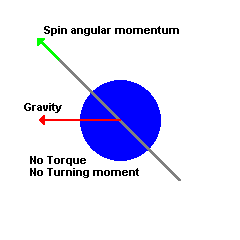 | The situation is very similar in the case of the Earth, but also crucially different. Despite myths that say the Earth is supported by four elephants standing on the back of a giant turtle, or on the shoulders of Atlas, or on Great Fish, of course it actually has "no visible means of support". Not that it needs any, as there is no net force pulling it anywhere that the entire Solar System isn't going as well. However, no point of support means no torque can be developed by a force acting on the Earth's centre-of-mass. Therefore, unlike the case of the gyroscope, the gravitational attraction of the Sun and Moon for the body of the Earth as a whole cannot induce precession of the Earth's spin axis. |
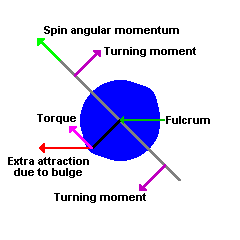 | What does cause precession is the fact that the Earth is not perfectly spherical - the most well-known lack of symmetry is the equatorial bulge produced by the Earth's rotation. Because the Earth is "leaning over" due to its obliquity of 23.44deg (exaggerated in these diagrams), the attraction of the Sun and Moon for the equatorial bulge produces an unbalanced force. If the spin axis is pointing towards the Sun (as on the left), because the lower part of the bulge is nearer to the Sun/Moon than the upper part, the gravitational force on the hemisphere below the plane of the Earth's orbit will be greater than that on the hemisphere above it. There will thus be a net torque tending to rotate the Earth around its centre-of-mass such that the obliquity is reduced. |
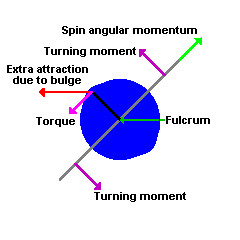 | Conversely, if the axis is pointing away from the Sun the upper part of the bulge is now the nearer and so the force on the lower hemisphere will now be less than that on the upper. The torque will thus again be in such a sense as to tend to reduce the obliquity. As with the gyroscope, this torque is opposed by the spin angular momentum, leading to precession. The precession will be about the centre-of-mass, being the "fulcrum" for the torque, and in the same plane as for the gyroscope because, although in the case of the Earth the gravitational force is "horizontal" rather than "vertical", the common plane of it and the angular momentum vector is still vertical: the resultant force is thus again in the horizontal plane. However! Because the turning moment is in the opposite direction to that for the gyroscope (tending to decrease the obliquity), the direction of precession is reversed: it is now in the opposite sense from the direction of rotation. This is a common source of error! Also, because the fulcrum is the centre-of-mass instead of a point outside the Earth, the "northern" and "southern" parts of the axis of rotation both describe a circle, not just the upper part as in the case of the gyroscope. This is shown in the second animation:- |
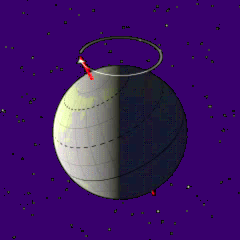 | It is very important to note, however, that precession does not change the obliquity. It changes the direction the spin axis is pointing at any given time but not its angle to the vertical. This is hopefully more obvious from the "3D-style" animations of the gyroscope and the Earth I have shown here than in some "flat" 2D diagrams you might have seen, where one could believe that precession caused the spin axis to oscillate to-and-fro rather than go round in a circle. It should be clear from the discussion of the cause of precession (above) that it could not affect the obliquity. This is because the net force causing precession is in the horizontal plane whereas it would have to be in the vertical plane to affect the obliquity. This of course invites the obvious question - if precession cannot cause a change in the obliquity (which is what we are meant to be discussing), why have I spent so much time explaining in such detail a phenomenon which is not relevant? The answer is that it is very relevant, though not in the direct way one might have imagined. |
Before I explain why, I need to deal with the related topic of Nutation (a word with a Latin root, meaning a "nodding" motion), which involves yet more discussion of precession! I said above that axial precession is caused by the gravitational attraction of the Sun and Moon for the slight variations of the Earth's shape from a perfect sphere. As should be clear from the diagrams above, the attraction will be at its maximum only when the Earth's spin axis is inclined directly towards or away from the Sun or Moon, so the bulges are as far "off-centre" as possible. With the Sun/Moon at 90deg to the plane of the spin axis (so the red arrow is now pointing "out of the page" rather than off to the left), there will be no imbalance of forces. All corresponding parts of the bulge on the upper and lower hemispheres are the same distance away from the Sun/Moon and so the attraction for a part of the bulge on one hemisphere will be exactly balanced by an equal attraction for the corresponding part on the other. No net force equals no torque equals no precession.
If we now consider what that means in the case of the Sun alone, it can be seen that at the northern summer solstice (when the Earth's axis is inclined directly towards the Sun) and the northern winter solstice (when it is inclined directly away) the precession-inducing force is at its maximum - these are the cases shown by the diagrams. Conversely, at each equinox (when the plane of the axis is at 90deg to the Sun) the force is zero. There is thus a 6-monthly variation in the precession-inducing force due to the Sun.
The situation for the Moon alone is considerably more complicated, because not only is there a similar max-min-max-min effect to that for the Sun (but this time at a periodicity of half a lunar month rather than half a solar year), there are also further effects resulting from the fact that the plane of the Moon's orbit is inclined to the general plane of the Solar System by, on average, 5.16deg and that this plane rotates once every 18.6yrs. This rotation is another example of precession, called orbital precession. In the same way that the Earth and its equatorial bulges can be regarded as a gyroscope, so can the entire Earth-Moon system. The non-spherical shape of the Earth is negligible at this scale and so the Earth acts as the shaft of the gyroscope with the Moon as the "wheel" - its orbital rotation is the "spin" factor. The off-centre attraction of the Sun for the Moon on its tilted orbit now takes the place of the attraction of Sun and Moon for the Earth's bulges, resulting in a precession of the entire orbit of the Moon rather than of the body of the Earth - this is why this type of precession is called orbital precession. Spin precession and orbital precession are really the same thing, however - it's just the scale that has changed, not the basic principles.
Working out what all this does to the the precession-inducing force of the Moon is, to put it mildly, not a topic for the faint-hearted! I consulted a number of texts giving the standard mathematical analysis of the situation and quickly came to the conclusion that this was "not my sort of mathematics"! I persevered however, and eventually found a treatment which used quite different analytical tools to avoid many of the complications caused by the spherical geometry of the situation. A detailed explanation of this treament would be way outside the scope of this article though, so I have placed it on an "extra page": click here to indulge in a considerable mental workout - note that I only claim that this treatment is easier to understand, not easy!
Whichever analysis you consult (and hearty congratulations if you worked through my offering and emerged without your brain exploding!), you will find it is important that the Moon's orbit is both inclined and subject to orbital precession. The asymmetry in the orbital geometry, and thus the gravitational attraction of the Moon, that these two effects produce is sufficient to cause variations in the rate of precession: this is nutation. The attraction is strongly dependent on the orientation of the Moon's orbit relative to the Earth's axis of rotation and so the nutation will have a periodicity equal to that of the orbital precession - 18.6yrs. The combined effect of both Sun and Moon will thus be to modulate the constant axial precession by factors of quite different periodicity: half a lunar month, half a solar year, and 18.6yrs. These variations are extremely small: the largest (due to the tilt and precession of the lunar orbit) is only of the order of 10 seconds of arc. The half-yearly variation due to the Sun is about 15 times less, and the half-lunar-month variation is about 85 times less. However, because the rate of axial precession is itself also very small (about 50 arc-seconds per year), nutation does actually make a significant difference, changing the precession rate by +/-34%.
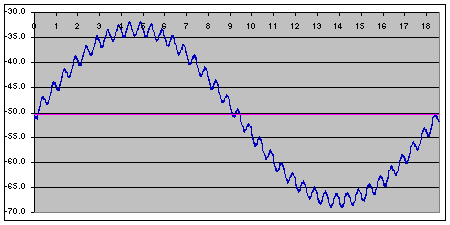 | This can be seen from the next diagram, taken from the Visualisation section of the "mental workout" page, which shows how the precession rate varies over a period of 18.6yrs: its mean value ranges from about -33.0 arc-sec/yr to about -67.5 arc-sec/yr. The small-scale changes are the half-solar-year modulations and the slightly "fuzzy" look is due to the half-lunar-month modulations. |
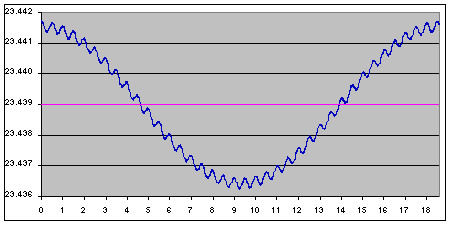 | This diagram shows the variation in the obliquity. Note that the y-axis covers only 0.006 of a degree! As with the precession-rate diagram, the small-scale changes are the half-solar-year modulations and the slightly "fuzzy" look is due to the half-lunar-month modulations. |
If we combine both the above diagrams, and thus show the variation from their mean values of both the precession rate (x-axis) and the obliquity (y-axis) over the 18.6yr cycle, the diagram below is what we get. In this case, the loops are due to the half-solar-year modulations and the "loops within the loops" are due to the half-lunar-month modulations.
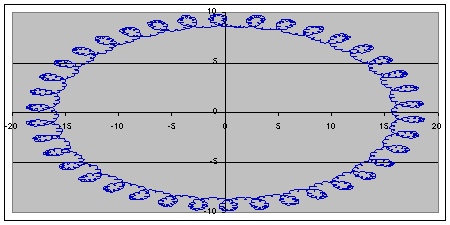 | It is extremely important to realise that this diagram does not show the motion of the Earth's axis under the influence of precession and nutation. Although it is tempting to assume that the main ellipse shows precession and the loops show nutation, this is not the case. In fact, the diagram only shows nutation, because the constant precessional motion has been taken out of the reckoning in order to show just the variations from the mean values - which is what nutation is. A similar diagram for a body which did not exhibit nutation would be just a single dot at the intersection of the axes, not a smooth ellipse. Why then have I shown a potentially confusing diagram? Because it can lead to further mis-conceptions when diagrams are drawn showing axial rotation, precession and nutation all together. This is something of a side-track though, so I have explored the topic on an extra page - click here to read it. |
While all the above is interesting from a pictorial point of view, the fact that the obliquity changes at all is the important point - it shows that whereas a symmetrically-acting torque cannot alter the obliquity a torque which is asymmetric in both time and space can. One can visualise this as a sort of "reverse precession": the addition of an extra force in the direction of the precession induces a turning moment on the axis. This can be seen by playing with a toy gyroscope: if it is held with its spin axis parallel to the ground and then slightly rotated in a horizontal plane, the axis will tilt upwards (or downwards!). Any variation in the rate of precession due to an asymmetric torque will thus produce a corresponding alteration in the obliquity. Having established this, we can move on to examine influences on the obliquity other than the Sun and Moon.
Before we do so though, it is important to realise that, while the above analyses may seem all rather esoteric, the results do directly affect us here on Earth. The consequences are of interest even for those who haven't been brave enough to have ploughed through all the maths (precession actually determines how many leap years we have!), so I have placed the information on an extra page. Click here to read all about it.
It must be emphasised however that luni-solar precession and nutation will not, of themselves, have any effect on the Earth's climate or the stability of its axis. Precession changes the "pointing direction" of the axis rather than its angle and the variations in obliquity produced by nutation are not only almost negligibly small but also strictly periodic (and so even any trivial effects will average out over a very brief timescale). However, the existence of axial precession does provide a means by which significant changes in obliquity can be produced by external influences. The stability of the Earth's axis depends on the extent to which these changes are periodic or chaotic, and it is here that the Moon may have a vital role to play.
Although perturbations to the obliquity of the Earth will be dominated by the Moon (because of its close proximity) and the Sun (because of its large mass), the influence exerted by the other planets in the Solar System is by no means negligible. The two greatest effects are due to Venus (the closest planet to us) and Jupiter (the most massive planet). Venus is 66 times as massive as the Moon but 100 times as far away. Gravitational attraction is proportional to mass and inversely proportional to the square of the distance, and so the attraction of Venus for the Earth is (at their point of closest approach) 1/150 of that of the Moon. Jupiter is 26000 times as massive but 1500 times as far away and so its attraction is 1/91 of that of the Moon. These are both small numbers but not so small they can be ignored: planetary effects in fact add about 0.13 arc-sec/yr to the 50.29 arc-sec/yr precession caused by just the Sun and Moon.
Because the eccentricity and inclination of the orbits of the planets are not constant when considered over long time periods, the effect they have on the Earth's precession rate is also variable, in both time and space, leading to a potential for "externally induced nutation" as described above i.e. a periodic variation of the obliquity. Although the influence of the planets is very small, the change in obliquity it produces is in fact very much larger than that produced by the Sun and Moon, causing the axial tilt to oscillate between 22.1 and 24.5 degrees in a cycle of about 41,000 years. The obvious question is - how can such a small influence produce such a large change? The answer is to be found in the phenomenon of resonance. This is the process by which small forces can, if applied at exactly the right time, produce an effect which builds up in magnitude out of all proportion to the input. The classic example is pushing a swing. If the push is applied correctly the swing can be made to move through a considerable arc with very little effort. Conversely, if the push is at the wrong time or at the wrong rate the swing will hardly move. The correct time and rate is when the pushes are in harmony with the natural oscillation frequency of the swing. The nearer the two are together the greater the amplitude of the motion. Now the natural frequencies of orbital changes in the Solar System are very long - of the order of tens or hundreds of thousands of years in fact. For example, the luni-solar precession rate of the Earth is one cycle in 25,772yrs (corresponding to 50.29 arc-sec/yr). The perturbation due to the Moon, with a periodicity of 18.6yrs, is thus so different from the natural period that its effect on the obliquity will be very small - as we have seen. Planetary influences have timescales very much closer to the Earth's natural period however, and so their effects can build up through resonance to produce a much greater end result.
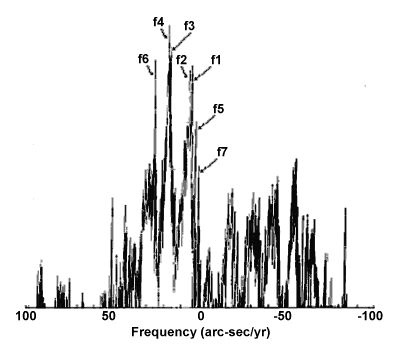 Determining what the timescales actually are is a difficult matter though, as the various influences all interact. It is as if there were several people all pushing on the same swing at different times and with different strengths. Furthermore, because the influences can depend on both the orbital eccentricity and the orbital inclination of the perturbing planet (both of which are subject to precession), there are actually two sets of interaction timescales. Mathematical models of the interactions can be constructed though, and techniques such as Fourier analysis can then tell us what the resultant frequencies are. As can be seen from the diagram on the left, the outcome is complex, with very many driving frequencies, but seven of them are particularly strong: I have labelled them f1 to f7 (the order in which they are numbered reflects the conventional numbering scheme). Note that, although it is not shown, the vertical scale of this diagram is logarithmic: the major peaks are thus actually over a hundred times as large as the minor ones, not just two-and-a-bit times. The two sets of influences have very similar patterns, but in the case of orbital inclination there is no equivalent of f5 (as this turns out to be the case when all orbits are in the same plane, when there can be no perturbations). The magnitude of the corresponding frequencies in each set is also very similar but, importantly, the sign is positive for eccentricity and negative for inclination as they precess in opposite directions.
Determining what the timescales actually are is a difficult matter though, as the various influences all interact. It is as if there were several people all pushing on the same swing at different times and with different strengths. Furthermore, because the influences can depend on both the orbital eccentricity and the orbital inclination of the perturbing planet (both of which are subject to precession), there are actually two sets of interaction timescales. Mathematical models of the interactions can be constructed though, and techniques such as Fourier analysis can then tell us what the resultant frequencies are. As can be seen from the diagram on the left, the outcome is complex, with very many driving frequencies, but seven of them are particularly strong: I have labelled them f1 to f7 (the order in which they are numbered reflects the conventional numbering scheme). Note that, although it is not shown, the vertical scale of this diagram is logarithmic: the major peaks are thus actually over a hundred times as large as the minor ones, not just two-and-a-bit times. The two sets of influences have very similar patterns, but in the case of orbital inclination there is no equivalent of f5 (as this turns out to be the case when all orbits are in the same plane, when there can be no perturbations). The magnitude of the corresponding frequencies in each set is also very similar but, importantly, the sign is positive for eccentricity and negative for inclination as they precess in opposite directions.
Both influences produce a group of four frequencies with magnitudes ranging from 3.0 to 7.5 arc-sec/yr (f7, f5, f1, f2); another pair around 18 arc-sec/yr (f3, f4), and one at 28 arc-sec/yr (f6). None of these major driving frequencies is sufficiently close to the Earth's axial precession frequency to cause a true resonance however. One might think that the peak just below 50 arc-sec/yr might have a dramatic effect, being almost exactly equal to the Earth's axial precession rate. In fact, because the peak is quite small in absolute magnitude (as explained above) and is the result of a complex triple interaction between influences from Jupiter and Saturn, it has little actual effect.
Despite the fact that the Earth does not have a true resonance with the planetary perturbations, there are still interactions at work - mainly so-called "pseudo-periodicities" between the Earth's precessional period and the frequencies corresponding to f3 and f4. As mentioned above, there are actually two sets of these, conventionally called "g" (due to changing orbital eccentricity) and "s" (due to changing orbital inclination). If we call the Earth's precessional frequency p, the pseudo-periodicities will thus be p+g3, p+g4 and p+s3, p+s4. Substituting actual values (and remembering that the s values are negative), we find that, when the resulting frequencies are converted to periods in years, we get 19116, 18964, 41052 & 39683 years respectively. The second pair of values are, of course, the timescale of the variation in the obliquity of the Earth mentioned above! Theory and observation thus tie up very nicely. The first pair of values are also significant, in that they appear in the theory of Milankovitch Cycles which attempts to explain the periodicity of climatic variations (particularly Ice Ages) in terms of variations in the orbital parameters of the Earth [it should be noted that Milankovitch also quotes a periodicity of 23,000yrs, which is close to the period of each of the interactions p+g1, p+g2 & p+g5].
Interestingly, the fact that the pairs of values are close together produces another interaction, called a beat frequency. This is a purely "mechanical" phenomenon, nothing to do with perturbations as such, and happens because the oscillations produced by the two frequencies slowly slip in and out of phase with each other. When they are exactly in phase the sum-total of their effects is a maximum. As they slip out of phase the sum decreases until, when they are exactly out of phase, the sum is a minimum. As they slowly come back in phase again the sum increases, back to the next maximum. In the time it takes to go from one maximum to the next, the higher frequency will have oscillated by exactly one cycle more than the lower frequency. Now if the frequencies are F1 and F2 cycles per second, in one second the higher frequency will complete (F1-F2) more cycles than the lower one. The time for just one extra cycle will thus be 1/(F1-F2) seconds: this is the period of the "beat". Its frequency will thus be (F1-F2) i.e. the difference between the two original frequencies.
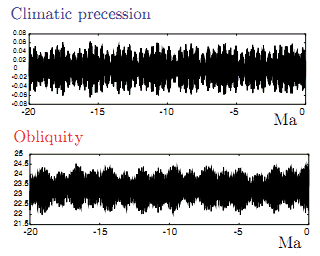 In the case of perturbations, because the pairs of driving frequencies are very close together the period of the difference frequency is very large. The beats can be seen in the diagram at the left, which shows how the Earth's precession rate and obliquity vary over a long time-period. The beats are the large-scale variations in the overall envelope of the graphs, at 2.379 million years for the g3/g4 beat (upper) and 1.190 million years for the s3/s4 beat (lower). Note, however, that the obliquity envelope is also modulated by the g3/g4 beat - this is shown by the fact that alternate peaks in the envelope are higher than their neighbours. It is probably significant that the g3/g4 beat is almost exactly twice the s3/s4 beat i.e. this a true resonance, albeit a "higher-level" form of resonance than that between the basic driving frequencies and precessional periods. This means that the variations in eccentricity and obliquity keep in step with each other over very long periods of time, which may well be responsible for changes in the Earth's climate over geological timescales. The underlying short-period variations in the eccentricity and obliquity are too rapid to be seen on the timescale used here - the "sawtooth" particularly noticeable in the upper graph is in fact a further beat frequency with a period of about 400,000yrs. This is produced by an interaction between the p+g2 and p+g5 periodicities. There are also beats at even shorter timescales - both graphs have them at around 100,000yrs, for example, which may well be the cause of the variations in the Earth's eccentricity at this periodicity.
In the case of perturbations, because the pairs of driving frequencies are very close together the period of the difference frequency is very large. The beats can be seen in the diagram at the left, which shows how the Earth's precession rate and obliquity vary over a long time-period. The beats are the large-scale variations in the overall envelope of the graphs, at 2.379 million years for the g3/g4 beat (upper) and 1.190 million years for the s3/s4 beat (lower). Note, however, that the obliquity envelope is also modulated by the g3/g4 beat - this is shown by the fact that alternate peaks in the envelope are higher than their neighbours. It is probably significant that the g3/g4 beat is almost exactly twice the s3/s4 beat i.e. this a true resonance, albeit a "higher-level" form of resonance than that between the basic driving frequencies and precessional periods. This means that the variations in eccentricity and obliquity keep in step with each other over very long periods of time, which may well be responsible for changes in the Earth's climate over geological timescales. The underlying short-period variations in the eccentricity and obliquity are too rapid to be seen on the timescale used here - the "sawtooth" particularly noticeable in the upper graph is in fact a further beat frequency with a period of about 400,000yrs. This is produced by an interaction between the p+g2 and p+g5 periodicities. There are also beats at even shorter timescales - both graphs have them at around 100,000yrs, for example, which may well be the cause of the variations in the Earth's eccentricity at this periodicity.
The very near resonance between g3/g4 and s3/s4 means that it would take only a very small change in the underlying driving frequencies to produce a perfect 2:1 resonance, which would tend to induce instabilities in the motion of the inner planets of the Solar System. A similar resonance between Jupiter and Saturn is thought to have happened during the early part of the development of the Solar System, throwing Jupiter in towards the Sun. This produced considerable disturbance to the orbits of, in particular, the material we now know as the asteroid belt, causing much of it to impact on the inner planets and the Moon in what is called the Late Heavy Bombardment.
So what is the difference between a resonance, a pseudo-periodicity and a beat? The answer is that a resonance exists when the extra "push" from the driving force happens at the same point in the orbit each time and thus strongly reinforces a motion which would naturally have occured at this frequency but with a very much smaller amplitude. In the case of a pseudo-periodicity the push happens at a point which steadily moves round the orbit. This difference means that, while the regular effect of a pseudo-periodic push will change the orbital elements, it will not do so to such an extent as would a resonance as there will not be a naturally-occuring motion at this frequency: this is why it's called a pseudo-periodic effect. I have illustrated a further example of this difference in my article on perturbations to the orbit of the asteroids by Jupiter. Asteroids whose orbital period is in a true resonance with that of Jupiter are liable to be ejected from their orbits as a result of the large changes induced, while those in a pseudo-periodic relationship (such as minor planet Ceres, whose orbit I analyse in great detail) simply undergo large but stable swings in their orbital parameters. The pseudo-periodic influences on the Earth's obliquity thus cause it to oscillate through a range of 2.4deg rather than to swing chaotically around, as a resonance could tend to do. Finally, a beat is simply a product of other perturbations, which generates further variations at very long timescales due to the shorter-period effects alternately reinforcing and opposing each other. While not itself a driving force, a beat can thus still produce "resonance-like" amplification due to this process of addition and subtraction. Whichever form of disturbance is considered though, it is clear that all three can have a significant effect.
Having analysed the stability of the Earth's obliquity in some detail, I shall now do the same for the two other planets which somewhat resemble the Earth.
The BBC2 programme compared the stability of the Earth with that of Mars, so I shall now do the same. Mars has two moons, Phobos and Deimos, but they are very small and so their influence on the planet is correspondingly reduced. Also, Mars is further from the Sun than the Earth and so the influence of the Sun is smaller as well. Thus, despite the fact that its spin rate is almost identical to that of the Earth, the axial precession rate of Mars is much slower - currently just 7.59 arc-sec/yr in fact. This rate is extremely close to the major driving frequency at 7.46 arc-sec/yr and so we might expect a considerable resonance effect. But is there?
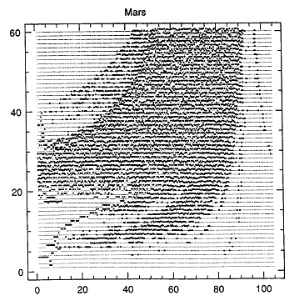 | Early work concentrated directly on the effect of the interactions between the major driving forces and Mars' axial precession. This indicated that because of the near resonance mentioned above, and the proximity of the other strong drivers, Mars sat just within a region of chaotic disturbance which could cause its obliquity to vary from as little as 0 degrees to as much as 60 degrees. The diagram to the left, taken from the original work published by Laskar & Robutel in the journal 'Nature' in 1993, shows this. The x-axis is the obliquity, the y-axis is the precession rate, and the black dots indicate the calculated area of chaotic disturbance. It can be seen that a precession rate of 7.59 arc-sec/yr sits within the lowest "arm" of the chaotic area, which spans the obliquity range quoted. The conclusion was that the interactions would cause Mars' obliquity to move through this range over relatively short timescales. This is very much what the programme showed - a planet wildly swinging between two extremes. |
The several simulations of the long-term evolution of the Solar System that have been done over the last couple of decades confirm this analysis to some extent, as they all show that the obliquity of Mars is indeed subject to both large magnitude periodic changes and sudden jumps in value.
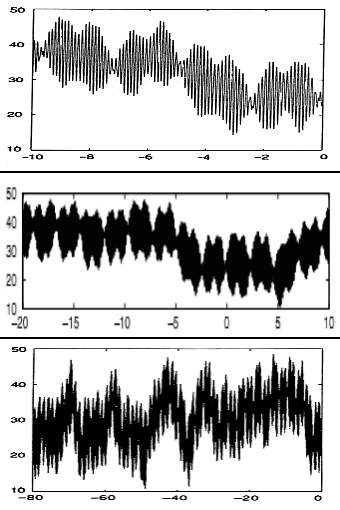 | The next set of diagrams (taken from Touma & Wisdom, 'Science' 26th Feb 1993, and Edvardssohn & Karlssohn, Astronomical Journal April 2008) show this instability over steadily increasing timescales - back 10 million, 20 million and 80 million years respectively (note that the second one also shows the predicted situation for the next 10 million years into the future). It can be seen that the graph from -20 to +10 million years has significant similarity to that for the Earth, above, in that the envelope of quite rapid oscillations is modulated at a much slower rate. In fact, these modulations are caused by exactly the same beat frequencies as for the Earth: because the beats are the difference between p+s3 and p+s4 the "p" factor cancels out i.e. the beats are a function of the interactions between the driving frequencies rather than the planets' reaction to them. One thus again sees major variations every 2.4Myr modulated by smaller variations at 1.2Myr intervals. There are three very large differences, however. Firstly, the envelope of the obliquity variations for Mars is much greater than that for the Earth - a range of typically +/-10 degrees rather than +/-1.25 degrees. Secondly, the depth of the beat frequency modulations is much greater for Mars than for the Earth i.e. the range varies by a much greater amount over the beat cycle. Thirdly, and most importantly, the range of the variations tends to jump about unpredictably, typified by the considerable change that is calculated to have occured about 4 million years ago. Several more shifts are shown in the bottom graph. Note, however, that the absolute range (i.e. ignoring beat effects) of the variations in each period of relative stability is approximately constant. It is thus the mean value of the obliquity which changes, not the magnitude of its variation. |
The obliquity of Mars varies much more than that of the Earth because it is, as we saw above, influenced by true resonance effects rather than just pseudo-periodicities. The resonance is not quite exact, however, so while the variation is large it is not drastically so. The different way the beat frequencies modulate the overall envelope is a reflection of the fact that while the frequencies of the perturbing forces (and thus the beats) are the same as for the Earth, because of Mars' different orbit their relative magnitudes and phase relationships are not i.e. the underlying factors are the same but their higher-level effects are different. Finally, the sudden jumps are caused by a phenomenon known as "resonance capture". I said above that the resonance of the precession period of Mars with the g2 driving frequency is not quite exact, but in fact the near-resonance affects the precession period in such a way that, together with the influence of the near-by g1 frequency and the other more minor driving forces seen in the "Fourier analysis" diagram (above), for a time the two can adopt a relatively stable relationship before rapidly flipping into another, different, stable state. The forces involved do not change, however, and so the range of the variations stays relatively constant. This behaviour is chaotic, in the mathematical sense of the word i.e. it does not have a definite periodicity or amplitude, thus accounting for the somewhat random nature of the obliquity graph out to 80 million years.
It should be noted, however, that while the total range of the variations in obliquity is chaotic and significant (ranging from 11 to 48 degrees) if considered over a very long timescale, the range is considerably less than that predicted by the frequency-based analysis (0 to 60 degrees). In addition, only a fraction of this range is traversed, and in a fairly regular fashion, during periods spanning millions of years. There is also some suggestion that tidal dissipation and interactions between the core and mantle of Mars may have damped the wilder obliquity fluctuations [see 'Non-chaotic obliquity variations of Mars' by Bruce G.Bills, NASA Goddard Space Flight Center, in Lunar and Planetary Science XXXVII 2006]. The picture the programme painted of the obliquity of Mars constantly varying wildly over a very large range is thus almost certainly inaccurate. It is fair to say, however, that even the more regular variations shown by the simulations would be not be helpful to, for example, the emergence of land-based life-forms, because of the very large changes in solar energy received by a land-mass whose effective latitude shifted by +/-10 degrees every 125,000 years or so. Taking into account the variations in the eccentricity of the Martian orbit, the change at northern latitudes (which are more important than the tropics due to the existence of ice and polar caps in this region) is about +/-50% for Mars compared to only +/-15% at most for the Earth. This is not to say that such a change would be completely disastrous though, because the very long periodicity would make it possible for mobile life-forms to migrate north and south to track the climatic changes. Paradoxically, it would be very much more difficult for advanced life-forms to cope with such variations, due to their more location-specific lifestyles - as we are discovering with the current global-warming trend. It is however true that the programme almost certainly over-stated its case in showing the obliquity variations in the way it did.
It is instructive to do a similar stability analysis for Venus because, according to the flawed logic of the programme, its obliquity should be extremely unstable due to the planet's remarkably slow axial rotation period - Venus takes longer to spin on its axis than it does to orbit the Sun (243.0 days against 224.7 days). Not only that, it does so in a retrograde manner i.e. clockwise (when viewed from above the Earth's north pole) rather than anti-clockwise. Another way of looking at this is to refer to its obliquity as 177.36deg: that is, to regard it as being "upside down". Either way, it's all a bit odd! Despite the fact that its axial rotation period is 243 days, its retrograde spin means that its solar day (the time interval after which the Sun returns to the same place in the sky) is only 116.8 days.
Those who were brave enough to have read my mathematical analysis of precession and nutation will know that the precession rate is increased by a reduced distance to the Sun, a decreased obliquity and a slow spin rate. Venus has all three of these (its "effective" obliquity is 2.64 deg, as being upside down does not affect things) and so, despite not having a moon to add its contribution, its precession rate is surprisingly rapid - 44.74 arc-sec/yr. The one thing that could have decreased the rate severely - the lack of an equatorial bulge, because of its very slow rotation rate - is actually compensated for by its greater "tri-axial asymmetry". This refers to the difference in shape when measured round the equator, round the 0deg line of longitude and round the 90deg line of longitude. In the case of the Earth, the equatorial diameter is slightly greater than the other two, but they are almost the same as each other: this gives the Earth its equatorial bulge but a negligible tri-axial asymmetry. In the case of Venus, not only is there a difference in the two "longitude" diameters but also the polar and equatorial asymmetries are (while still small in absolute terms) of very similar relative magnitudes [see 'Rotation of rigid Venus: a complete rotation-precession model' by L.Cottereau and J.Souchay, Observatoire de Paris, in Astronomy & Astrophysics February 26th 2010]. This lack of overall symmetry provides the "handle" upon which gravitational forces can act to produce precession effects.
We thus see that Venus' precession rate is almost as distant from a driving frequency as that of the Earth and so, far from being extremely unstable, it should actually be rather stable. In fact, as well as being stable due to having a rapid precession rate, the retrograde rotation makes it even more so because the motion is in the opposite direction to the perturbing forces from the other planets. This was probably not always the case though, as how it acquired its slow and retrograde rotation is a matter of conjecture. A likely hypothesis is that in a much earlier epoch its rotation was fast and direct (i.e. anti-clockwise) and so its consequentially much slower precession rate did indeed leave it vulnerable to an instability which flippped its obliquity and reduced the spin rate.
So - where have we got to thus far? I firstly showed that any spinning body will tend to remain in a stable orientation because the spin angular momentum vector resists change in both its magnitude and its direction. The greater the angular momentum, due to the body having a high spin-speed and/or a large moment of inertia, the more stable the body will be. Because of the vector nature of angular momentum, an external force acting so as to change the angle of the spin axis (for example because the body is axially asymmetric) will actually cause the body's spin vector to rotate round a vertical axis at constant obliquity - this motion is called axial precession.
If the external force varies in both time and space an extra motion is induced, called nutation. Nutation causes a fluctuation in the precession speed and a periodic variation in the obliquity. In the case of the Earth, where the varying external force is provided primarily by the Moon, the magnitude of these changes is extremely small because the timescale of the variations in the Moon's orbit (tens of years) is drastically different from the timescale of precession (tens of thousands of years) and so the natural "inertia" in the system almost completely damps out the nutation - particularly the variations in obliquity. However, the perturbing forces provided by the other bodies in the Solar System have natural periods of the same order as that of planetary precession and so, although the magnitude of these forces is very much smaller than those of the Moon, they can have a much greater effect through the mechanism of resonance. This is the process by which small forces applied at exactly the right moment can reinforce each other, causing the perturbations to rapidly build up. Even if there is no true resonance, other interactions between the driving forces and precessional motion can cause periodic changes in the obliquity which are very much larger than natural nutation, and "beats" between changes whose periods are almost the same can further modulate the variations.
In the case of the Earth, because its precessional period is much shorter than the period of any of the driving forces (although of the same order of magnitude), there is no resonance. However, the "other interactions", called pseudo-periodicities, do have an effect and lead to a variation in the obliquity of about +/-1.25 degrees over a timescale of about 41,000 years. Beats then modulate this change at periods of 1.2 and 2.4 million years. Mars has a precessional period which is almost exactly in resonance with a major driving frequency and so it experiences much greater variations in obliquity - about +/-10 degrees in 125,000 years. The near-resonance also causes the mean value of the variations to jump chaotically, although this happens on a very long timescale - typically five to ten million years. Venus has, mainly due to its very slow axial rotation, a precessional period only slightly greater than that of the Earth so is (now) similarly stable, particularly because it exibits retrograde rotation. In the past, however, it is likely that an original very much faster direct rotation rate caused it to fall foul of an extreme resonance-induced event which flipped its obliquity and drastically reduced its spin speed - a dramatic illustration of the power of a strong resonance.
However, while this is all very interesting, I hear you say, I thought this article was about the stabilising effect of the Moon on the Earth's obliquity? If the obliquity is basically stable anyway, where does the Moon come into it? Read on!
Throughout the analyses above I have frequently referred to the separate contributions the Sun and the Moon make to the axial precession of the Earth, without actually quantifying their relative magnitudes. In fact, as those who fought their way through the mathematical derivation will know, of the 50.29 arc-sec/yr precession rate induced by the Sun and Moon together the Sun provides only 15.95 arc-sec. Therefore, were the Moon to suddenly disappear but all other factors remain unchanged, the total axial precession rate of the Earth would be just 16.08 arc-sec/yr (15.95 plus 0.13 for the influence of the other planets). This would put it uncomfortably close to the s3/s4 and g3/g4 pairs of driving frequencies which sit from 17.4 to 18.8 arc-sec/yr.
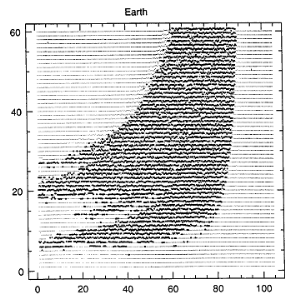 | In fact, a "frequency domain" analysis, like that described above for Mars, indicates that if this situation were to occur the potential range of obliquity variation could be as great as 0 to 85 degrees! The "stability map" for the Earth is shown on the left. Fortunately, also as in the case of Mars, a detailed orbital simulation reveals that, while the Earth would indeed experience chaotic variations in its obliquity, only a small part of the theoretical range would be explored during any quasi-stable state and the total range is most unlikely to be as large as the frequency-domain analysis would indicate. This may well be because, as can be seen from the diagram, a precession rate of 16.08 arc-sec/yr in fact sits in a significant "gap" in the stability map and so the chaotic domain would not begin to be entered until the obliquity exceeded about 25 degrees. This is illustrated by the next set of diagrams, from an important paper by Lissauer, Barnes & Chambers in the journal 'Icarus', Vol 217, of October 2011, which give the obliquity of a moonless Earth before and after the present on various timescales, ranging from millions of years at the top to billions of years at the bottom. It can be seen that, although the range of the short-term variations is much greater than it is now, the variation in the range over very long timescales is actually quite constrained and significant chaotic behaviour does not set in until after 1 billion years in the future. |
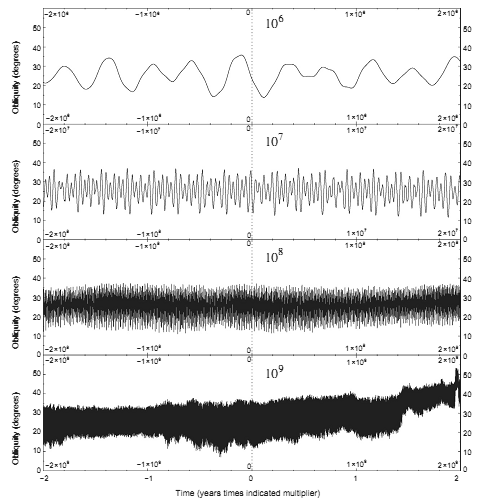 The big problem with the above is that we almost certainly cannot assume that "all other factors remain unchanged". Most importantly, we have no way of knowing what the spin rotation period of the Earth would now be if the Moon had never existed at all. There is currently no theory that can predict the "as created" spin rates of the planets, and in any case they are all very likely to have experienced a number of major collision events since the formation of the Solar System which would almost certainly have changed their spin. As the precession rate of a lone planet is almost entirely determined by its spin rate it is therefore impossible to say whether a moon-less Earth would have a stable obliquity or not. All we can say is that if its moon-free spin rate was somewhat more than twice its present rate (or faster) then it would probably be stable but if its spin was slower than this then significant instability is likely. How I arrive at this conclusion is not as obvious as it might seem, however, as it apparently contradicts the principle mentioned above in connection with Venus that a slow spin rate leads to a rapid precession rate (and therefore a greater likelihood of avoiding a resonance). The explanation lies in another failure of the "all other factors remaining unchanged" assumption.
The big problem with the above is that we almost certainly cannot assume that "all other factors remain unchanged". Most importantly, we have no way of knowing what the spin rotation period of the Earth would now be if the Moon had never existed at all. There is currently no theory that can predict the "as created" spin rates of the planets, and in any case they are all very likely to have experienced a number of major collision events since the formation of the Solar System which would almost certainly have changed their spin. As the precession rate of a lone planet is almost entirely determined by its spin rate it is therefore impossible to say whether a moon-less Earth would have a stable obliquity or not. All we can say is that if its moon-free spin rate was somewhat more than twice its present rate (or faster) then it would probably be stable but if its spin was slower than this then significant instability is likely. How I arrive at this conclusion is not as obvious as it might seem, however, as it apparently contradicts the principle mentioned above in connection with Venus that a slow spin rate leads to a rapid precession rate (and therefore a greater likelihood of avoiding a resonance). The explanation lies in another failure of the "all other factors remaining unchanged" assumption.
It is certainly true to say that, for a given planet in a given state, its precession rate is proportional to its axial asymmetry and its orbital speed relative to those bodies causing the precession, and inversely proportional to its obliquity and spin speed. This just provides us with a mathematical formula for calculating the rate from a set of [assumed constant] values, however, not a model telling us how a change in the various factors will affect the rate. This is because the factors are not independent. Crucially, for a planet which is not totally solid (like the Earth), the "equatorial bulge" will grow larger if the planet spins faster, increasing the axial asymmetry (and thus the precession rate). This increase in fact scales as the square of the spin speed [see 'Astronomical forcing through geologic time' by A.Berger & M.F.Loutre in Special Publication 19 of the IAS 2004, page 19], and so if we are constructing a model within which we can vary the parameters to see what happens, the precession rate ends up being proportional to the spin speed rather than inversely proportional (as A2 x 1/A = A). Although this sounds contrary, it is simply a consequence of making the dependence of the asymmetry on the spin speed explicit in the case of the model and implicit in the formula: the dependency will already have been taken into account when the axial asymmetry value was calculated (or measured) for use in the formula.
The fastest driving frequency is about 28 arc-sec/yr and so if we wish to ensure that the precession rate is fast enough to avoid all the major driving frequencies we need to aim for a value rather in excess of this. A value of 32 would seem a good choice, as this is just on the edge of the chaotic zone of the Earth's stability map for obliquities around the present value. Given that the "no Moon" precession rate is 16.08 arc-sec/yr with a day-length of 24hrs, proportionality tells us it would be over 32 arc-sec/yr with a day-length of 12hrs or less - hence my conclusion above. If the day-length was as short as 8 hours, the moonless Earth would have almost the same precession rate, and thus stability, as the "with-Moon" Earth has now.
While we cannot tell with certainty whether an Earth which never had a moon would have been stable or not, it is rather more interesting to consider the case which actually exists - the Earth with a Moon which, though definitely present, is slowly receding from the Earth. You didn't know it was? Yes indeed - at about 38mm per year currently. This is another topic covered by the programme (somewhat inaccurately, you will not be surprised to learn!) and which I have explored in considerable length as part of my dissertation on The Tides. I shall not go into any detail here, therefore. Suffice it to say that the Earth-Moon system is slowly losing energy due to friction between the oceanic tides and the body of the Earth. This causes the spin speed of the Earth to decrease, which in its turn causes the Moon to recede from the Earth in order to conserve angular momentum. Over time, therefore, the length of both the day and the lunar month increase. However, (though I did not cover this aspect in my other articles) it's not just the size of the Moon's orbit that will change. Because the spin axis of the Earth and the orbital axis of the Moon are not parallel, the interactions between the Earth and the Moon will cause all the orbital parameters to vary: in particular, the eccentricity and inclination of the orbit. Conservation of momentum in a vertical plane will thus cause the Earth's obliquity to steadily increase as the inclination of the Moon's orbit decreases: there is a similar effect due to the action of the Sun [see 'Contributions to the Earth's obliquity rate, precession and nutation' by J.G.Williams in The Astronomical Journal vol 108, no.2 (1994), page 719]. Note that this is a secular (i.e. continuous over time) increase, not a periodic variation of the type we have been considering so far.
We thus see that, as the Moon recedes, all the variables that influence the Earth's axial precession rate will change - except one, the Earth's orbital speed round the Sun. The spin speed of the Earth & the orbit speed of the Moon are decreasing and the obliquity is increasing. All three changes act to decrease the precession rate. I was able to accurately calculate the decrease by using data produced as a result of my earlier studies on the Moon's recession, which gave me the change in the Earth's spin speed and the Moon's orbit speed at a large number of points over several billion years. From these, I set up further expressions which firstly calculated the axial asymmetry and then the precession rate, using the formula I derived in my studies of luni-solar precession but taking into account the effect of the increasing obliquity.
It turns out that the net result is a rather gradual decrease in the precession rate. Even allowing for the effect the Sun has in increasing the Earth's obliquity [which I did take into account when calculating the "moonless" figures above], the rate is still 36 arc-sec/yr after 1.5 billion years. The 32 arc-sec/yr point used above would take 2 billion years to reach, and the rate doesn't get down to the "no-Moon" value of 16.08 until 5.1 billion years have passed. It should, of course, be noted that both Earth and Moon will be destroyed by the Sun at about the 5 billion year mark as it expands to form a Red Giant star! Thus, while the recession of the Moon is certainly causing the Earth to approach a situation where its obliquity could become unstable, it is doing so exceedingly slowly. Furthermore, the elapsed times quoted are likely to be under-estimates, as the standard theories of the recession of the Moon (such as I derived) do not take into account the changing obliquity of the Earth. This is important because these theories assume that the recession is due to the transfer of angular momentum from Earth to Moon as the Earth's spin slows. While this is true, there must still be a mechanism by which the angular momentum is transferred: this will clearly be less efficient the more the spin axis of the Earth is out of line with the orbital axis of the Moon.
It is perhaps reasonable to assume that the "efficiency factor" will simply be proportional to the cosine of the Earth's obliquity: any variation due to the inclination of the lunar orbit will cancel out over quite short timescales due to its 18.6yr precession period, which results in it subtracting from the obliquity equally as often as adding to it. Because of the way the cosine function varies, this factor only becomes significant (which I have taken to mean less than 0.95) once the obliquity increases beyond 18 degrees. At its current value (23.439 deg) the factor is 0.917. Interestingly, if we multiply the rate of recession calculated on the basis of perfect momentum transfer (41.825 mm/yr) by this factor the result is 38.373 - exceedingly close to the measured value of 38.247! Maybe there's something in this efficiency argument after all. However, whether or not this is a coincidental result, it is clear that any effect will have been relatively small in the past (and so will hardly affect any "evolution of the Moon's orbit" arguments) but will be potentially much greater in the future.
Taking the efficiency factor into account, a precession rate of 36 arc-sec/yr is not now reached until 1.7 billion years and it takes 2.3 billion years to get down to 32 arc-sec/yr. The above conclusion is thus strengthened - while the recession of the Moon and the consequences leading from it are indeed tending to leave the Earth's obliquity vulnerable to instability, this effect is considerably less severe than many commentators have assumed. In addition, although the Earth will almost certainly eventually stray into the zone of potential instability, the results of the orbital simulation studies indicate that this does not necessarily mean that large-scale chaotic changes in the obliquity will immediately occur. It is rather more likely that (initially, at least) a "Mars-like" regime will be entered, with quite long periods when the obliquity moves between limits which, although much wider than currently, are nothing like as dramatic as a simplistic interpretation of the stability-map would indicate. Only when the precession rate has dropped sufficiently to take the Earth well into the resonance zone is it probable that large-scale chaotic behaviour will appear: this is likely to take at least a further billion years, however.
It took a very long time to get there, but I think we are now in a position to give a judgement on the assertion made by the programme - does the presence of the Moon stabilise the Earth's obliquity?
Unfortunately, while the answer is definite it is unavoidably ambiguous, as it has to be qualified by a number of if's and but's. What my investigations have shown is the following:-
So, while the Moon stabilises the obliquity of the Earth in the situation we are now in (in that its presence converts a quasi-stable state with relatively large but regular obliquity variations and the potential for future chaotic instability into a definitely stable state with small variations) we cannot say for certain whether the current situation with the Earth being accompanied by the Moon is any more stable than the situation that would by now have been reached had the Earth never had a moon in the first place. This is essentially the conclusion arrived at by Lissauer, Barnes & Chambers when they say "A large moon thus does not seem to be needed to stabilize the obliquity of an Earth-like planet on timescales relevant to the development of advanced life.". It is however possible to say that the presence of the Moon is something of a double-edged sword. Though currently a stabilising influence, it is inexorably (though slowly) driving the Earth towards an axial instability it may well never have acquired if the Moon had not been in orbit round an Earth whose initial spin rate rendered its obliquity stable from the time it first came into existence.
As is often the case, therefore, the answer depends to a large extent on the meaning you attach to the question and the context in which you pose it.